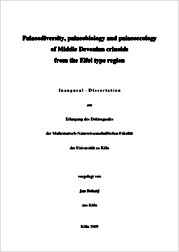Palaeodiversity, palaeobiology and palaeoecology of middle devonian crinoids from the Eifel type region
Bohatý, Jan
Univ. Köln
Monografie
Verlagsversion
Deutsch
Bohatý, Jan, 2009: Palaeodiversity, palaeobiology and palaeoecology of middle devonian crinoids from the Eifel type region. Univ. Köln, 263 S., DOI: 10.23689/fidgeo-174.
 |
Dokument öffnen: |
This doctoral thesis deals with crinoids from the Middle Devonian (U. Eifelian to L. Givetian) of the Eifel Synclines (western Rhenish Massif, Germany) and secondary with U. Eifelian to U. Givetian crinoids of the eastern Rhenish Massif. The study focuses on new recovered material and on material deposit in historical collections. Since the classic monographs of the early 19th century, crinoids are nearly unstudied in modern view. They are only periphery mentioned within the standard works Treatise on Invertebrate Paleontology and Fossil Crinoids. The Eifel has to be characterised as the global hotspot of Middle Devonian crinoids. Because of the high diversity, selected groups of each of the four occurring Palaeozoic subclasses are studied in the course of this work: 1. The subfamily Cupressocrininae (subclass Cladida); 2. the family Hexacrinitidae (subclass Camerata); 3. the genus Stylocrinus (subclass Disparida); 4. the genus Ammonicrinus (subclass Flexibilia). Altogether, four families, eight genera and 66 species are described taxonomically. 10 new species are erected newly. Based on the excellent three-dimensional preservation of the partly autochthon conserved skeletons and their ecological-/facial response, the Eifel crinoids gave important information about the palaeodiversity, palaeobiology and palaeoecology: Regeneration processes in cupressocrinitids and hexacrinitids correspond with that features defined for recent echinoderms. Because of their important functions, the regeneration of injured arms is more perfect than those of affected cups. Hexacrinites contra balanced the general smallness of the regenerative arms by an increased pinnulated surface ...

